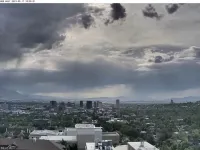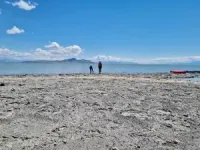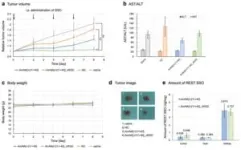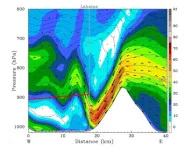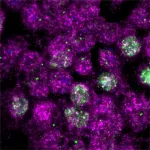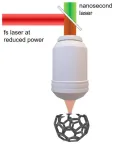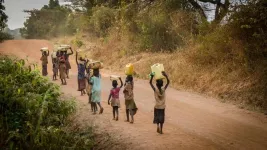(Press-News.org) New research from the University of Utah demonstrates how wind-carried dust from the exposed bed of Great Salt Lake is disproportionately affecting disadvantaged communities in the Salt Lake metro area.
The findings suggest restoring the lake to a healthy water level would reduce disparities in harmful dust exposure experienced by different racial/ethnic and socioeconomic groups, along with delivering other ecological and economic benefits.
Exposure to particulate pollution arising from dry portions of the playa is highest among Pacific Islanders and Hispanics and lowest among white people compared to other racial/ethnic groups, according to the findings reported June 21 in the journal One Earth. It was also higher for individuals without a high school diploma.
This is likely because Salt Lake City’s lower-income neighborhoods are more likely to lie in the path of windblown dust from Great Salt Lake, which has shrunk to less than half its historical size, leaving about 800 square miles of lakebed exposed.
More than two decades of drought and unrelenting upstream diversions have contributed to the decline of the saline terminal lake located immediately west and north of Utah’s main population corridor along the Wasatch Front.
“People here in Utah are concerned about the lake for a variety of reasons—the ski industry, the brine shrimp, the migratory birds, recreation—and this study adds environmental justice and the equity implications of the drying lake to the conversation,” said lead author Sara Grineski, a professor of sociology and environmental studies.
Grineski led an interdisciplinary team of U faculty, largely associated with the Wilkes Center for Climate Science and Policy, from both the College of Social and Behavioral Science (CSBS) and the College of Science. Co-authors are Timothy Collins and Malcolm Araos (geography); John Lin, Derek Mallia and Kevin Perry (atmospheric sciences); and William Anderegg (biology).
The study analyzed data from the Utah Department of Environmental Quality’s air-quality monitoring network, which screens for fine particulate matter, or PM2.5. Comprised of ultra tiny particles that can penetrate lung tissue, this pollution is linked to myriad health problems, including cardiovascular disease and asthma.
During dust storms, current levels expose residents to 26 micrograms per cubic meter, or μg/m3, of PM2.5 on average, according to the study, significantly higher than the World Health Organization’s threshold of 15 μg/m3. Were the lake to dry up completely, exposure could rise to 32 μg/m3, while restoring the lake could reduce exposure to 24 μg/m3 during these wind events, according to the study.
The study examined four such events in 2022 on April 19, 20 and 21 and May 7, when spikes of recorded PM2.5 coincided with high winds.
For the study, which was funded by the National Science Foundation, researcher Derek Mallia developed a model for predicting exposure levels for the three counties abutting the lake’s east and south shores—Salt Lake, Davis and Weber, home to 1.8 million residents—under four different lake level scenarios. It uses a weather model that simulates wind direction and speed, and includes a wind-blown dust model, which measures how much dust is emitted from an erodible surface, such as the Great Salt Lake playa, and is primarily based on the wind speed and soil texture and characteristics.
“We have to use weather models, since we cannot physically go out to the lake and remove/add water to see how much more/less dust it would emit,” Mallia said. “Models like the one that I developed let us run these hypothetical scenarios.”
The study’s scenarios range from a totally dry lake, to very low lake level, to current lake, to ‘healthy’ lake level designated as 4,200 feet above sea level. The lake’s South Arm currently sits at 4,194.4 feet, almost 6 feet higher than the historic low of 4,188.7 registered at the end of 2022.
According to the model, neighborhood disparities in exposure levels would increase when the lake level drops.
“We frame it the converse. Lake levels rise, overall levels of dust go down during the dust events and the gap, especially between Hispanic and Pacific Islander people, narrows with respect to the level of dust exposure for non-Hispanic white people,” Grineski said. “So if we can take better care of the lake, the dust for everyone goes down and the gap in exposure between these groups goes down too.”
Her team’s prior research has previously documented disparities of PM2.5 exposure generally in the Salt Lake Valley
“There is a really strong pattern of inequality with respect to race and ethnicity,” she added. “It’s sort of a hopeful finding that if we can raise the lake to a ‘healthy’ level we can at least with respect to lake dust we can reduce some of that inequality.”
Most dust from the playa is PM10, pollution comprised of much larger particles that are only measured at a few of Utah’s air quality monitoring stations. Without a robust PM10 monitoring network, researchers and regulators are deprived of a key data source that could give a more complete assessment of the lakebed dust threat, according to co-author Kevin Perry. He said the study points to the need for Utah to expand its network of PM10 monitors since windblown lakebed dust contains about six times more PM10 than PM2.5.
“We have to use the PM2.5 data because that’s the network that we have available. It’s not what I would design and not what I would like to do,” he said. “Because of the network being so sparse, I can’t even answer a really basic question, like how many dust events do we have a year that are impacting these communities. And that’s super frustrating.”
A professor of atmospheric science, Perry is known as “Dr. Dust” thanks to his tireless bicycle forays across the vast lakebed gathering sediment samples. These sediments were found to be contaminated with heavy metals in some places.
He noted that potentially harmful dust events typically occur in the spring and fall when cold fronts pass through the Wasatch Front.
“Before a cold front gets here, we have really strong winds from the south that will last for 12 or 18 hours,” Perry said. “And where’s it pushing that dust? It’s pushing it to Layton, Syracuse, Ogden, Brigham City where we have almost no PM10 monitors at all, and then the wind reverses and we’ll get three to four or five hours of stuff coming into Salt Lake Valley where we do have monitors.”
Because of its ability to infiltrate living tissue, PM2.5 is considered more harmful to human health than PM10, which is also classified as a criteria pollutant under the federal Clean Air Act.
END
How dust pollution from shrinking Great Salt Lake affects communities disproportionately
Research highlights social justice implications of restoring the Utah lake
2024-07-03
ELSE PRESS RELEASES FROM THIS DATE:
Clever clothes! Seams in clothing capture body movement
2024-07-03
Everyday clothing may soon be able to capture and record body movements according to new research published by the Universities of Bristol and Bath.
Harmless low voltages are passed through conductive threads which are stitched into garment seams to create electrical circuits. Their resistance changes with the movement of the wearer's body. The work opens up new possibilities to make digital clothing which senses and captures movements much more accurately than is possible using current phones and smart watches.
The paper, presented at the Designing Interactive Systems (DIS) conference in Copenhagen ...
AMS science preview: Maui wildfire, Salt Lake drying, traffic and weather
2024-07-02
The American Meteorological Society continuously publishes research on climate, weather, and water in its 12 journals. Many of these articles are available for early online access–they are peer-reviewed, but not yet in their final published form.
Below is a selection of articles published early online recently. Some articles are open-access; to view others, members of the media can contact kpflaumer@ametsoc.org for press login credentials.
JOURNAL ARTICLES
Understanding Observed Precipitation Change and the New Climate Normal from the Perspective of Daily Weather Types in the Southeast U.S.
Journal of ...
Research spotlight: Identifying genes to prolong an anti-tumor immune response
2024-07-02
How would you summarize your study for a lay audience?
We set out to identify genes that are commonly expressed in CD8+ T cells, killer immune cells that can drive anti-tumor immunity, across many types of human cancers. Our goal was to uncover new therapeutic targets, which could inform novel treatment strategies that could benefit many patients. To do this, we developed a novel mathematical method that can be applied to data from many types of cancers.
What knowledge gaps does your study help to fill?
We know the presence fof CD8+ T cells is essential for ...
SRI is developing a new malaria treatment that aims to protect from the disease
2024-07-02
SRI today announced that researchers are developing a new treatment that aims to provide a better option to fight malaria, particularly for people in low-income and rural regions. Researchers in SRI’s Pharmaceutical Sciences Lab are working on an affordable, shelf-stable anti-malarial drug formulation that could provide months of protection against the mosquito-borne disease with just a single injection, which means that individuals would no longer have to worry about missing a dose. Additionally, it has a low propensity for resistance and can be ...
UV radiation damage leads to ribosome roadblocks, causing early skin cell death
2024-07-02
In a recent study, researchers at Johns Hopkins Medicine suggest the cell’s messenger RNA (mRNA) — the major translator and regulator of genetic material — along with a critical protein called ZAK, spur the cell’s initial response to UV radiation damage and play a critical role in whether the cell lives or dies.
While UV radiation has long been known to damage DNA, it also damages mRNA, and the latest findings, published June 5 in Cell, indicate that mRNAs act as first responders in telling the cells how to manage the stress.
“RNA is a canary in the coal mine. It’s telling the cell, ‘We’ve got major damage here and ...
Precise and less expensive 3D printing of complex, high-resolution structures
2024-07-02
WASHINGTON — Researchers have developed a new two-photon polymerization technique that uses two lasers to 3D print complex high-resolution structures. The advance could make this 3D printing process less expensive, helping it find wider use in a variety of applications.
Two-photon polymerization is an advanced additive manufacturing technique that traditionally uses femtosecond lasers to polymerize materials in a precise, 3D manner. Although this process works well for making high-resolution microstructures, it isn’t widely used in manufacturing ...
AGS member, George Kuchel, appointed to serve on ACIP
2024-07-02
The American Geriatrics Society extends its warmest congratulations to ADGAP President George Kuchel, MD, CM, FRCP on his appointment as a member expert of the Advisory Committee on Immunization Practices (ACIP). ACIP develops recommendations on the safe use of vaccines in the United States.
Dr. Kuchel, who became President of the Association of Directors of Geriatrics Academic Programs in spring 2024, is Director of both the UConn Center on Aging and the Claude D Pepper Older Americans Independence Center at the University of Connecticut. He has significant expertise and knowledge in vaccines and immunology, particularly in older adults, including performing ...
Researchers awarded Department of Defense grant to study the role of gut microbiomes to improve outcomes in dystonia
2024-07-02
Mohammad Moshahid Khan, PhD, principal investigator and associate professor in the Department of Neurology in the College of Medicine at the University of Tennessee Health Science Center, was recently awarded a $308,000 grant from the Department of Defense for a study that will investigate the role of the gut microbiome in dystonia, a movement disorder of abnormal postures and involuntary twisting or repetitive movements, to improve neurobehavioral outcomes. Jianfeng Xiao, MD, PhD, associate professor in the Department of Neurology, is the co-investigator of the study.
Although ...
Advancing toward a preventative HIV vaccine
2024-07-02
LA JOLLA, CA and NEW YORK, NY—A major challenge in developing a vaccine for HIV is that the virus mutates fast—very fast. Although a person initially becomes infected with one or a few HIV strains, the virus replicates and mutates quickly, resulting in a “swarm” of viral strains existing in a single body. But scientists at Scripps Research; IAVI; the Ragon Institute of Mass General, MIT, and Harvard; La Jolla Institute for Immunology; and additional institutions have conducted a series of preclinical ...
A Global Heat Early Warning system is now essential, and requires planning in four key areas to overcome barriers and enable successful implementation, per new review
2024-07-02
A Global Heat Early Warning system is now essential, and requires planning in four key areas to overcome barriers and enable successful implementation, per new review.
####
Article URL: https://journals.plos.org/climate/article?id=10.1371/journal.pclm.0000437
Article Title: Preventing heat-related deaths: The urgent need for a global early warning system for heat
Author Countries: Austria, Denmark, Sweden, Switzerland, US
Funding: CB,IMO, CG and JT are funded by Horizon Europe through the HIGH horizon project funded by the European Union’s Horizon Europe Programme (grant number 101057843). IMO and CG are also ...
LAST 30 PRESS RELEASES:
Numbers in our sights affect how we perceive space
SIMJ announces global collaborative book project in commemoration of its 75th anniversary
Air pollution exposure and birth weight
Obstructive sleep apnea risk and mental health conditions among older adults
How talking slows eye movements behind the wheel
The Ceramic Society of Japan’s Oxoate Ceramics Research Association launches new international book project
Heart-brain connection: international study reveals the role of the vagus nerve in keeping the heart young
Researchers identify Rb1 as a predictive biomarker for a new therapeutic strategy in some breast cancers
Survey reveals ethical gaps slowing AI adoption in pediatric surgery
Stimulant ADHD medications work differently than thought
AI overestimates how smart people are, according to HSE economists
HSE researchers create genome-wide map of quadruplexes
Scientists boost cell "powerhouses" to burn more calories
Automatic label checking: The missing step in making reliable medical AI
Low daily alcohol intake linked to 50% heightened mouth cancer risk in India
American Meteorological Society announces Rick Spinrad as 2026 President-Elect
Biomass-based carbon capture spotlighted in newly released global climate webinar recording
Illuminating invisible nano pollutants: advanced bioimaging tracks the full journey of emerging nanoscale contaminants in living systems
How does age affect recovery from spinal cord injury?
Novel AI tool offers prognosis for patients with head and neck cancer
Fathers’ microplastic exposure tied to their children’s metabolic problems
Research validates laboratory model for studying high-grade serous ovarian cancer
SIR 2026 delivers transformative breakthroughs in minimally invasive medicine to improve patient care
Stem Cell Reports most downloaded papers of 2025 highlight the breadth and impact of stem cell research
Oxford-led study estimates NHS spends around 3% of its primary and secondary care budget on the health impacts of heat and cold in England
A researcher’s long quest leads to a smart composite breakthrough
Urban wild bees act as “microbial sensors” of city health.
New study finds where you live affects recovery after a hip fracture
Forecasting the impact of fully automated vehicle adoption on US road traffic injuries
Alcohol-related hospitalizations from 2016 to 2022
[Press-News.org] How dust pollution from shrinking Great Salt Lake affects communities disproportionatelyResearch highlights social justice implications of restoring the Utah lake
